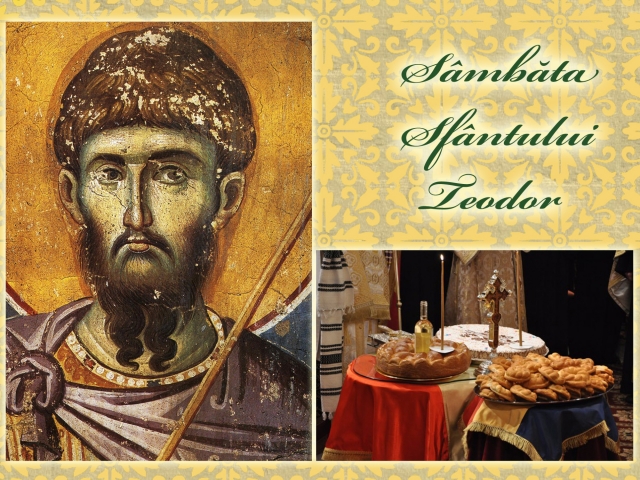 The commemoration of the appearance of Saint Theodore and the miracle of the kolyva is celebrated on the first Saturday of Great Lent each year with a Divine Liturgy and a Memorial Service. This day is the last of three Saturday of Souls observed each year at the beginning of the Lenten season. The faithful bring kolyva and lists of names of friends and family members who have reposed in the faith. The names are read by the priest during the Memorial Service.
The commemoration of the appearance of Saint Theodore and the miracle of the kolyva is celebrated on the first Saturday of Great Lent each year with a Divine Liturgy and a Memorial Service. This day is the last of three Saturday of Souls observed each year at the beginning of the Lenten season. The faithful bring kolyva and lists of names of friends and family members who have reposed in the faith. The names are read by the priest during the Memorial Service.
” Feast of the Holy Martyr Theodore Tyron is, according to Karabinov, the oldest fixed holiday in the liturgical cycle . The enduring popularity of this saint whose shrine attracts crowds of Euhaita , made his memory be transferred to the first Saturday of Lent, as the Typikon of the Great Church ” . ( Monk Makarios Simonopetritul )
It is not just about a transfer of celebration commemorated by Triod. For, while the Great Church Typikon indicates not only Synaxis for martyrs. Triod this day commemorates the kolyva miracles more precisely , whose narration is attributed to the patriarch of Constantinople Nectarios ( late fourth century ) .
During the tyrannical reign of the emperor Julian the Apostate , he commanded to sprinkle the blood of animals sacrificed to idols on all products sold in the imperial city , to defile the first week of Lent for Christians . But the martyr Archbishop Theodore appeared in a dream then, Eudoxius ( 360-369 ) , revealing the plan of Julian and advising him to boil the grains of wheat ( Kolyva ) and distribute them to residents of Constantinople so that they do not buy from the market.
Thus free from defilement of idolatry Surp thanks to this martyr, Archbishop commanded the faithful to celebrate every year at the end of the first week of Lent, a feast commemorating this event. This first Saturday is therefore at a double joy: the conclusion of the first period of fasting and celebration for the martyr.
“Let us rest on this Saturday, people, ceasing the labors of yesterday, the one who blessed this day of rest and celebration of the martyr now.”
Therefore, the day job does not have “Alleluia” to fall asleep, as in other Saturdays, but “God is the Lord.” Hymnal includes pieces reserved praise of Theodore and other miracles of kolyva. Raphael reading which recounts this miracle is complemented by the panegyric of St. Gregory of Nyssa Theodor awarded.
Commemorating the martyr Theodor Tyron on Saturday is normally devoted to the collective memory of the saints and martyrs therefore, as an indication of its enrolling as a kind of conclusion to the series of three festive Saturdays: Saturday of the Dead, Saturday of ascetic and Saturday of Theodore.
On the other hand, except Saturday of Akatistos, other Saturdays of Lent will not include special commemorations, thus allowing the celebration of kolyva, highlighting the privileged character of the first week. At the conclusion of the latter, the congregation of martyrs led by St. Theodore represented associates, therefore, prayers and its examples the efforts of believers to help them on their path that remains to be done in the coming weeks.
“Fasting pure and blameless reaching us now, brought committing wonders by martyrs. For fasting cleanses us from the filthiness and uncleanness of the soul, and by evidence and valiant battles over the passions comforted. For this and the gift of the holy fasting, enlightening us with miracles and martyr Theodore, strengthening our faith in Christ, we ask Him to give salvation of our souls. “
As in Saturday of Souls after Vespers on Friday we proceed to Panihide and blessing of the kolyva , but there’s a little different meaning . It’s less than the survival of ancient funerary feasts of the early Christians , as an office celebration commemorating the miracle victory against kolyva and insidious plan of Julian the Apostate , thanks to the intervention of the martyr Theodore.
